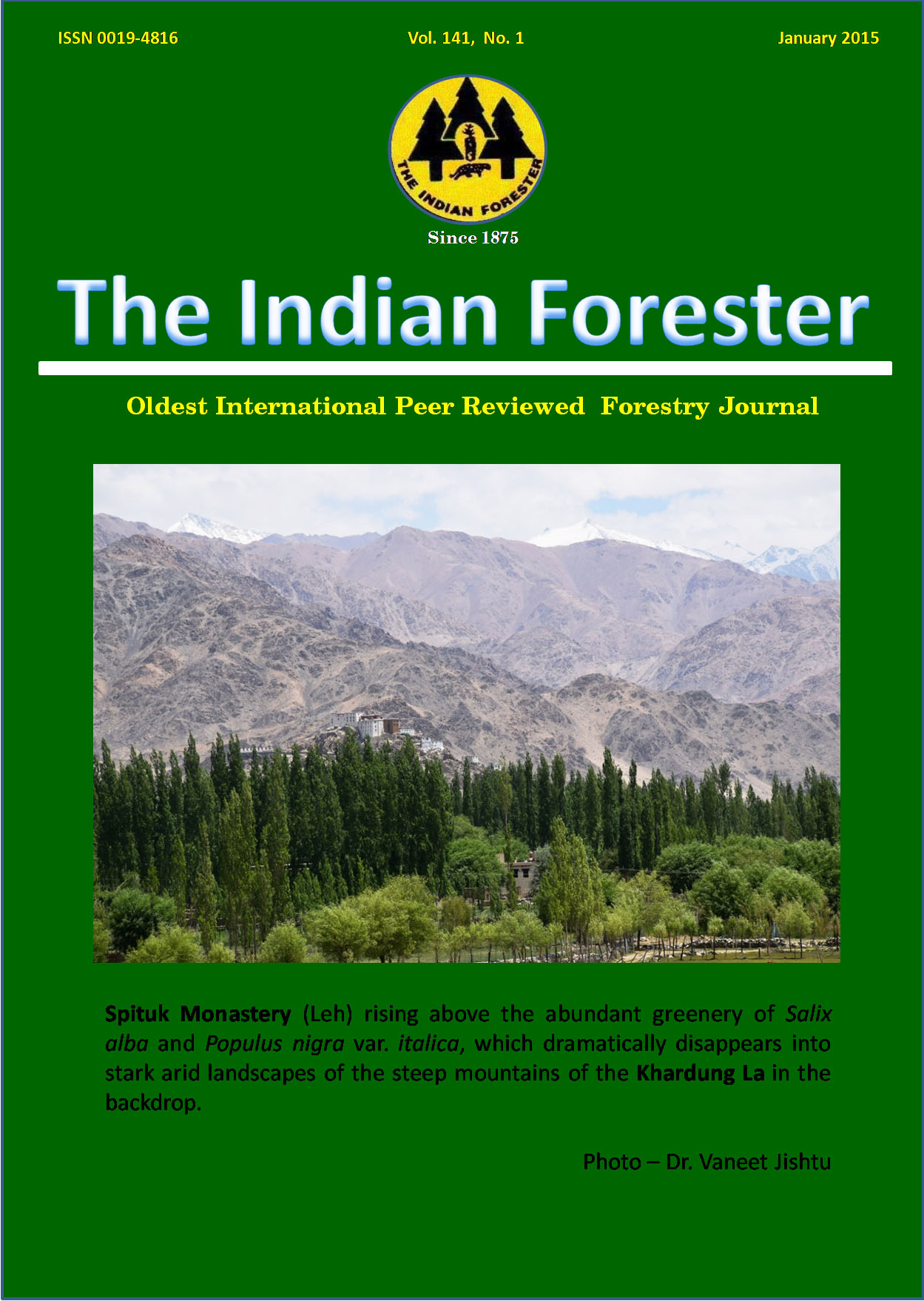Extent of Lopping in Relation to Acorn Production of Quercus floribunda Lindle Forests
DOI:
https://doi.org/10.36808/if/2015/v141i1/56817Keywords:
Fodder, Lopping, Acorns.Abstract
Quercus floribunda (Moru oak) (Local name Tilonj) is an important element of western and central Himalayan vegetation. Lopping practice is very common in the forests and plantations especially near the habitation. Q. floribunda tree is lopped for fodder, which is the most appreciated among all oaks. However, heavy and indiscriminate lopping continues throughout the year which results pole like appearance of the trees with scanty leaves. Lopping of Q. floribunda results in poor production of acorns. The study suggests that there is need to understand the effect of lopping on acorn production to have sustainable lopping levels.References
Baland J.M., Bardhan P., Das S. and Mookherjee D. (2010). Forests to the people: Decentralization and forest degradation in the Indian Himalayas. World Development, 38:1642-1656.
Collins B.S. and Pickett S.T.A. (1987). Influence of canopy opening on the environment and herb layer in a northern hardwood forest. Vegetatio., 70:3-10.
Gorrie R.M. (1937). Tree lopping on a permanent basis- Indian Forester, 63 (1): 29-31.
Greenberg C.H. (2000). Individual variation in acorn production by five species of Southern Appalachian oaks. Forest Ecology and Management, 132(7):199-210.
Grime J.P. (1979). Plant Strategies and Vegetation Processes. Willey and Sons, New York.
Joshi B., Tewari A. and Rawat Y.S. (2009). Population dynamics of Quercus floribunda Lindl. seedlings under denser and lighter canopied microhabitats. Nature and science, 7(1):84-90.
Joshi H.C. (2002). Assessment of habitat diversity, forest vegetation and human dependence in the buffer zone of Nanda Devi Biosphere Reserve of west Himalaya, Ph.D Thesis, Kumaun University, Nainital.
Koenig W.D., Knops J.M.H., Carmen W.J., Stanback M.T. and Mumme R.L. (1994). Estimating acorn crops using visual surveys. Can. J. For. Res., 24 (5): 2105-2112.
Makino Y. (1994). Forest use and regeneration in Tehri Garhwal Himalaya, India. In: pp. vii, 73 leaves. Ann Arbor: University of Michigan.
Makino Y. (2009). Oak forests, lopping, and the transformation of rural society in central Himalaya, India. A dissertation submitted in partial fulfillment of the requirements for the degree of Doctor of Philosophy. (Natural Resources and Environment) in The University of Michigan.
Maren I.E. and Vetaas O.R. (2007). Does regulated landuse allow regeneration of keystone forest species in the Annapurna conservation area, central Himalaya. Mountain Research and Development, 27 (4): 345-351.
Mathema P. (1991). Focus on oak forest. Banko Janakari, 3(1): 13-6
Moench M. and Bandyopadhyay J. (1986). People-Forest Interaction - A Neglected Parameter in Himalayan Forest Management. Mountain Research and Development 6(1): 3-16.
Nautiyal A.R., Thapliyal P. and Purohit A.N. (1987). A Model for Round-the-year Supply of Green Fodder in Hills. In: Western Himalaya,. (Y.P.S. Pangtey S.C. Joshi and D. R. Joshi Eds ) pp. 2 v. (viii, 860 ). Nainital, U.P.: Gyanodaya Prakashan.
Negi A.K., Bhatt B.P., Todaria N.P. and Saklani A. (1997). The effects of colonialism on forests and the local people in the Garhwal Himalaya, India. Mountain Research and Development, 17(2): 159-168.
Negi S.S. (1977). Fodder trees in Himachal Pradesh. Indian Forester, 103(9):616-622.
Orwa C., Mutua A., Kindt R., Jamnadass R. and Simons A. (2009). Agroforestry tree Database: a tree reference and selection guide version 4.0 World Agroforestry Centre, Kenya.
Rathore S.K.S., Singh S.P. and Singh J.S. (1995). Evaluation of carrying capacity with particular reference to firewood and fodder resources in
Central Himalaya: A case study of Baliya catchment. International Journal of Sustainable Development and World Ecology, 2(4): 285-293.
Reddy S.R.C. and Chakravarty S.P. (1999). Forest dependence and income distribution in a subsistence economy: Evidence from India. World Development, 27(7): 1141-1149.
Shrestha R.K. and Paudel K.C. (1996). Oak forest under threat: An urgent concern for the mountain environment. In: Environment and Biodiversity: In the Context of South Asia. (Jha P.K., Ghimire G.P.S., Karmacharya S.B., Baral S.R. and Lacoul P. Eds.) Publ. Ecological Society (ECOS), Kathmandu, Nepal. 114-119 pp.
Downloads
Downloads
Published
How to Cite
Issue
Section
License
Unless otherwise stated, copyright or similar rights in all materials presented on the site, including graphical images, are owned by Indian Forester.





